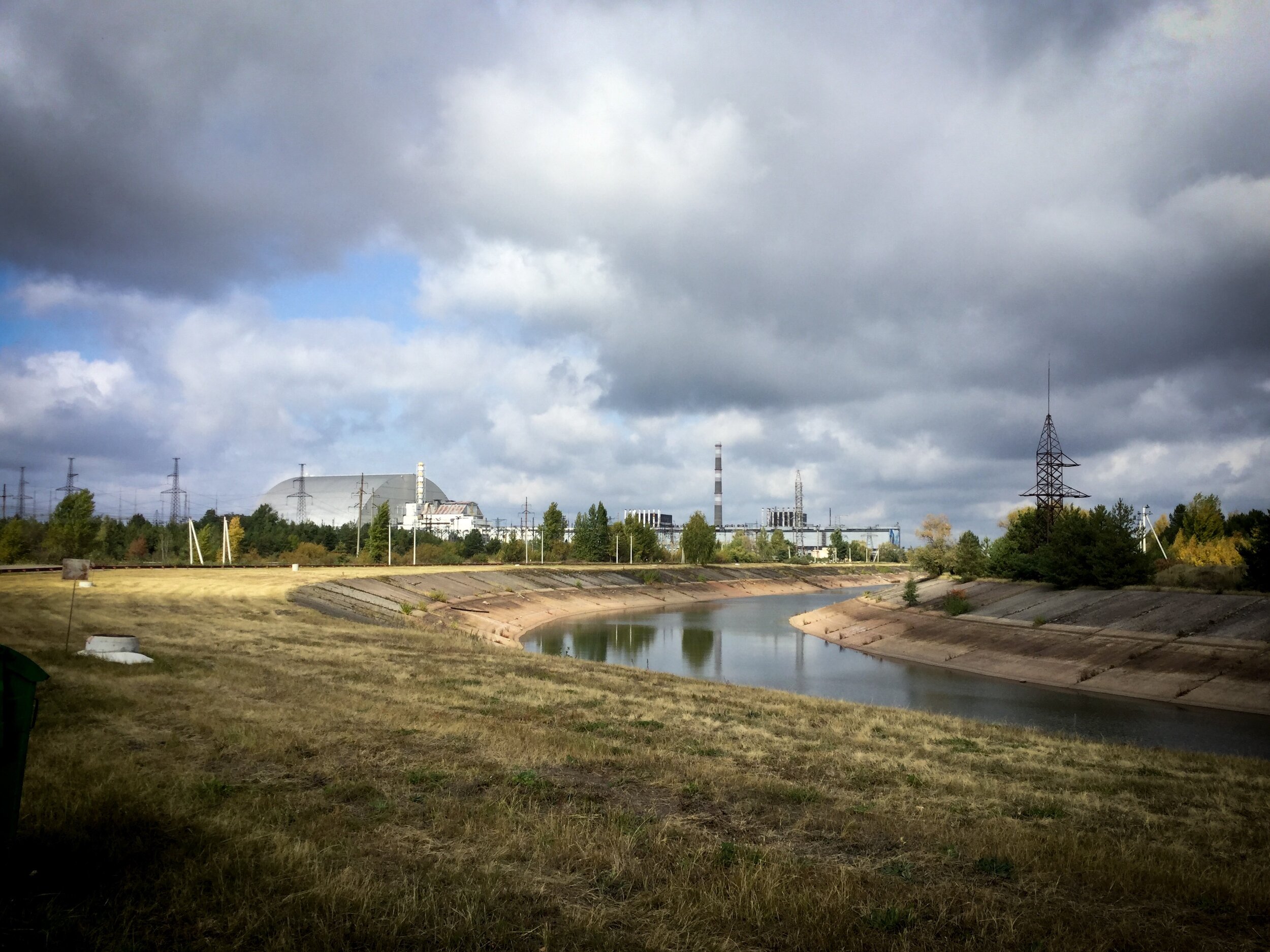Day 1 - Arrival
PM - Assembly in expedition hotel (stay there is optional)
PM - Sightseeing in Kyiv city and team dinner.
Day 2 - Expedition Begins
8:00 AM Kyiv - Dityatky Checkpoint
We pick you up in Kyiv at the expedition hotel where we will check all the passports, and then start driving to Chernobyl Zone. It takes approximately two hours to get to the main checkpoint of the Zone, located at the village of Dityatky, 110 km north from Kyiv. There we will stop for entry clearance, paperwork and safety briefing before entering the zone.
Zalissya village
After the drive to the town of Chernobyl via main highway, passing a bridge over the Uzh river, then the village of Cherevach and some abandoned agricultural fields we will then make a stop at Zalissya village to walk along one of it’s streets. This village is the biggest in Zone, as it was a home for more than 2800 residents and a host of huge collective farm called "Druzhba" ("Friendship") that was integrated in supply system of Chernobyl NPP and provided some types of goods for stores in Pripyat and canteens of NPP.
This part of our program aims to give you an understanding of history and living conditions of the Chernobyl region in pre-NPP period.

![DSC08137-[1600x1200].jpg](https://images.squarespace-cdn.com/content/v1/5d1f8b6514f05200011df35c/1585165257991-VEBTH61SSMTKAR1WPD4D/DSC08137-%5B1600x1200%5D.jpg)






Town of Chernobyl
Chernobyl is an ancient town and there is no clear information about the age, however it was first recorded in historical records in 1193. Being a center of Chernobyl district for the Kyiv region, it was once a normal neighborhood with approximately 13700 residents that, contrary to popular belief, were never related to Chernobyl Nuclear Power Plant (NPP).
It gave its name to the NPP as the closest town that existed in 1970. Before the disaster the town was an important port on the river of Prypiat. After the evacuation in 1986, Chernobyl has been converted to an administration center of the Chernobyl Zone and currently is home to many organizations and facilities. It has not changed very much and is a great example of a typical Soviet town. Although Chernobyl itself is not very rich for visual sites, a visit here allows to understand various aspects of the current life in the Zone.
Typically, we make stops:
at the entrance
at the central square, where near a large concrete-made map we explain a history of the area
at the bay of Chernobyl vessel repair base, which is final rest place for various cargo and passenger vessels that were used during the active stage of liquidation.
near the exhibition of robotic equipment, where we cover the questions of radioactive waste and decontamination. We can also stop in the local coffee shop!
Leliv checkpoint
We pass one more control at Leliv checkpoint, that marks the border of 10 km subzone. At some point we turn to the military concrete road and drive approximately 6 km to Chernobyl-2. This formerly secret town is hidden within dense forests. It was one of six components of Duga ("Arc") over-the-horizon radar complex, designed in 1970s to detect launches of U.S. ICBMs. The main point of interest there is breath taking array of 2 antennas, 148 x 500 m and 98 x 250 m as well as surrounding facilities. When we come to Chernobyl-2, we leave the car near its checkpoint, and go on foot to visit the antennas, go around the data processing center and other facilities, like the vehicles service depot.
As Chernobyl disaster caused a contamination of Chernobyl-2, being followed by end of Cold War and collapse of Soviet Union, the fate of Duga project was dark. It was cancelled and all the components were destroyed, except the array of Chernobyl-2. Returning to the main highway and heading towards the Chernobyl NPP, once on the way we make an introduction to radioactivity and measurements.





Kopachi village
This village, along with villages of Chystogalivka and Yaniv had a sad fate. Being built of wood, it faced extreme contamination and during the decontamination works 99% of structures were bulldozed and buried underground. Therefore, the area looks like a chaotic forest with lots of small hardly recognizable hills over the sites of initial structures.
Given that most of surface radioactivity is concentrated in the 10km subzone, this place is the first where we encounter significantly elevated levels. Shortly after Kopachi, we enter the former Red Forest site and the industrial area of Chernobyl NPP. Here we drive along the cooling channel, passing the unfinished cooling tower of Units V and VI, the storage for spent nuclear fuel #2 and unfinished Units V and VI (so-called Phase III, cancelled shortly after the accident).
Once we come closer to Phases I and II — main facilities of Chernobyl NPP, we stop to take in the panoramic view of the power plant. Here we explain how the NPP is organized int he compound, about design of reactors, shelter object and New Safe Confinement. After this, we drive between the NPP switchyard and the main complex, passing the western track of contamination, that once formed the infamous Red forest and come to the welcome sign of Pripyat.
City of Pripyat









We come to the city of Pripyat — the satellite town of Chernobyl Nuclear Power Plant, established in 1970 and 16 years old only at time of disaster.
Designed for 50.000 residents it consists of 5 districts and more than 180 structures. Approximately up to 2000 this city was mostly used in pretty the same way like Chernobyl now as a host for many organizations and companies of the Zone. Few facilities still operate in Pripyat.
We step out of our van at the central street and explore the city on foot up to 5:00 PM taking a balanced route, that features sights of various types. This allows you to venture deeper than regular sightseeing. We try to cover different aspects of life here, as well as Soviet reality. An average list of locations includes:
Avenue of Lenin, a central street of Pripyat
Litovchenko monumental mosaics
Yards of the District 2, that represent typical architecture and urban planning techniques of the ‘70s
Grocery store of the District 2
Liquor and furniture stores of District 2
School #2
Kurchatova street
Voskhod (Sunrise) store
Shopping center, which was one of the very first soviet supermarkets
Central square of Pripyat
Palace of culture 'Energetik', a multifunctional center for leisure and sports
Central park and infamous Ferris wheel.
Hotel Polissya
Governmental office, where after the accident has been deployed governmental commission in which participated Valery Legasov and Boris Scherbina
Music school
Prometheus cinema
River port
Hospital
Collapsed school #1
Yards of the District 1
«White house", a luxurious apartment complex, where lived highest staff of the NPP, including Victor Brukhanov.
Historical firefighters department — one of the first responders to the disaster call on April 26, 1986.
Vehicle junkyard in Pripyat
After this, we drive to exit, passing radiation screening at Leliv and Dityatky checkpoint.
Museum
The small secret museum is a carefully restored radiation control outpost from the Ilovnitsa village that operated in 1986-87 during the active phase of liquidation after the disaster at Chernobyl Nuclear Power Plant. Here you can see various artifacts, operating equipment and immerse into atmosphere of that times.
Dinner, shopping, accommodation
At 6 PM we arrive for dinner in a rural restaurant in Ivankiv district town. Then, we visit local supermarket in order to purchase supplies for the evening meal and for breakfast. After this, we travel to our overnight accommodation.



Accommodation at the research base of the Academy of science of USSR
This place is classical example of Soviet forest weekend escape! It is a group of small (and lovely) houses for 2-8 people in the pine forest. It was built in 1970s and after a few years of functioning was abandoned after the Chernobyl disaster. Shortly after this it was selected by Igor Ryabov — one the leading Soviet radiobiologists as a deployment point of long-term research expedition that was in action up to his death in 2004.
During next few decades, with the help of scientists, it was significantly rebuilt. There are a few laboratories along with a canteen and other infrastructure, but nevertheless, it keeps the feeling of the old harsh times. In the evening we have a briefing, during which we will answer your questions on the Zone, will share stories and show various archive items that will be a great addition to what you see in the Zone.
Day 3 - Power Plant Exploration
At 8:30 we set out from the base and drive to Dityatky checkpoint, pass the passport control once more and enter the Zone. After that, we drive to Chernobyl Nuclear Power Plant.


![DSC08104-[1600x1200].jpg](https://images.squarespace-cdn.com/content/v1/5d1f8b6514f05200011df35c/1585233703367-YABUC73SJ6NNTOS4YCPX/DSC08104-%5B1600x1200%5D.jpg)
![DSC08064-[1600x1200].jpg](https://images.squarespace-cdn.com/content/v1/5d1f8b6514f05200011df35c/1585233691395-OXOGZSGETO4UL30704RZ/DSC08064-%5B1600x1200%5D.jpg)

![DSC08043-[1600x1200].jpg](https://images.squarespace-cdn.com/content/v1/5d1f8b6514f05200011df35c/1585233673650-OXOXIPD6DL571V1YLL6B/DSC08043-%5B1600x1200%5D.jpg)
![DSC08075-[1600x1200].jpg](https://images.squarespace-cdn.com/content/v1/5d1f8b6514f05200011df35c/1585233691518-6ZJTGDFF1A4KJYQLYVG0/DSC08075-%5B1600x1200%5D.jpg)


Chernobyl NPP
We will meet representatives of the international cooperation department of Chernobyl NPP. Radiation screening of your body will be checked for presence of Cs-137 -at the ABK-1 Administration building .
This is the head office of Chernobyl NPP. Here you are issued with your pass ID and security clearances. Clothes changing facility available as you are you are required to change clothes to internal ones in order to proceed to maximum security area, the Golden corridor is a 600-m long corridor that connects all units together.
The program takes approximately 4.5-5 hours.
Average list of locations includes (depends on actual constraints and decision of Chernobyl NPP):
ABK-1 Administration building
This is the head office of Chernobyl NPP. Here you pass SICh (spectrometry of body), an ID and security clearances.Clothes changing facility
Here you have to change clothes to internal one in order to proceed to maximum security area.Golden corridor
A 600-m long corridor that connects all units together.Central control room - CSchU
Control room for the energy distribution switchyard of the power plant.SKALA mainframe computer system
Reactor control computer mainframe from 1973.Control room of Unit III - BSchU-III
Control room of Unit III.CZ-3 Unit III Reactor central hall
Reactor III hall, a main place for technological operations.Unit III 3GCN main circulation pumps
Gigantic pumps that were used to provide circulation of water through the active zone of the reactor of Unit III.Valery Khodemchuck memorial
A plaque installed on the wall the separates Units III and IV in memory of V. Khodemchuck -- operator of circulation pumps, that died during explosion and whose body was never found.Control room of Unit IV - BSchU-IV
Control room of Unit IV - a historical control room from which Unit IV was controlled.Observation point of NSC
A square in ±200 m distance from the New Safe Confinement.Observation hall of Shelter Object/NSC
A place to learn very much new about the original Shelter Object and the New Safe Confinement.
A tour inside the power plant includes also transfers on the service vehicle between premises of the NPP and a lunch at Canteen #19.
After this, we drive to exit, passing radiation screening at Leliv and Dityatky checkpoint and make the transfer to Kyiv.
Team dinner in Kyiv.
Day 4 - Departure
Transfer to the airport in the morning.





